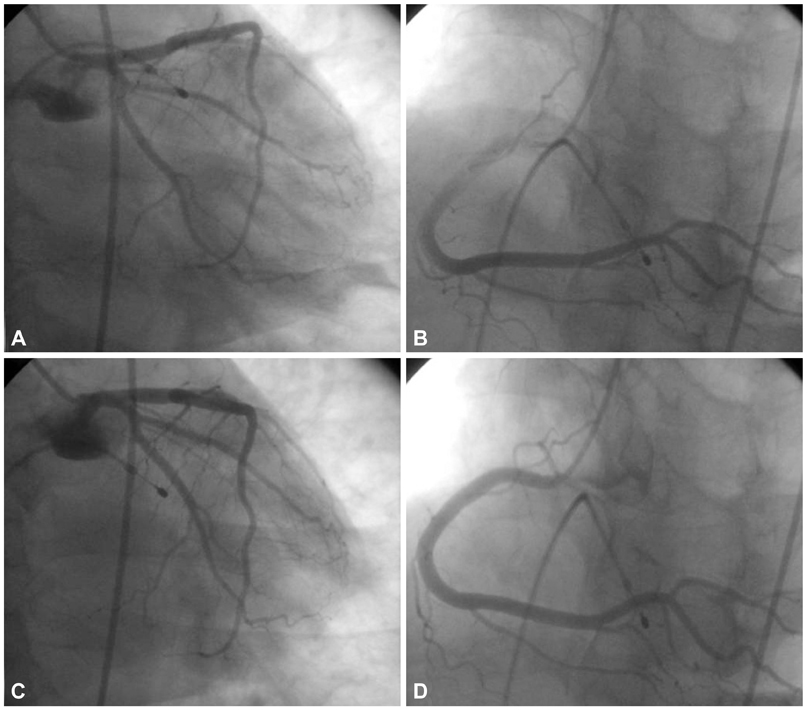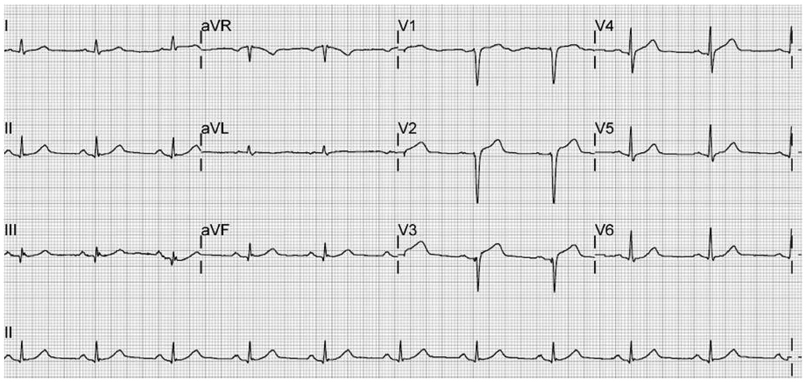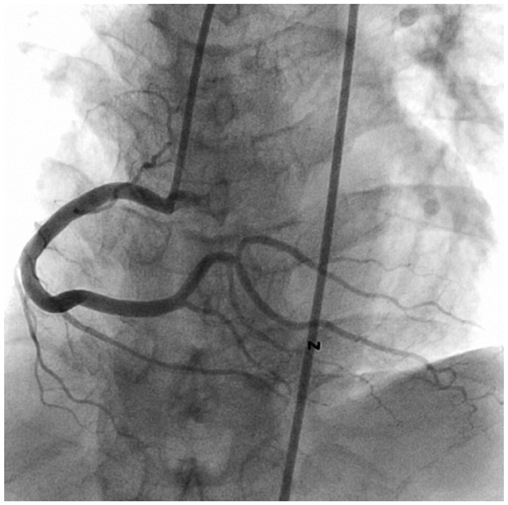Korean Circ J.
2013 Mar;43(3):199-203. 10.4070/kcj.2013.43.3.199.
Does a Negative Ergonovine Provocation Test Truly Predict Freedom from Variant Angina?
- Affiliations
-
- 1Cardiovascular Center and Department of Internal Medicine, Seoul National University Hospital, Seoul, Korea.
- 2Division of Cardiology, Department of Internal Medicine, College of Medicine, Seoul National University and Cardiovascular Center, Seoul National University Bundang Hospital, Seongnam, Korea. djchoi@snu.ac.kr
- KMID: 2224967
- DOI: http://doi.org/10.4070/kcj.2013.43.3.199
Abstract
- Ergonovine provocation test is known to be very sensitive for diagnosing variant angina. The patient described in this study initially presented with atypical chest pain and underwent coronary angiography and ergonovine provocation tests, which were negative. The patient was subsequently prescribed a proton pump inhibitor and prokinetics for pain relief, but then presented with acute myocardial infarction and cardiogenic shock due to coronary artery vasospasm 5 years later. This case suggests that ergonovine provocation test generates false negative results, which can lead to unwanted outcomes. Even with a negative ergonovine provocation test, prescription of calcium channel blockers or nitrates should be considered in patients with a clinical history suggestive of variant angina.
MeSH Terms
Figure
Reference
-
1. Prinzmetal M, Kennamer R, Merliss R, Wada T, Bor N. Angina pectoris. I. A variant form of angina pectoris; preliminary report. Am J Med. 1959. 27:375–388.2. Hanst PL, Spence JW, Clay FR. Chlorofluoromethanes: their thermal stability in passing through cigarettes. Am Ind Hyg Assoc J. 1978. 39:772–776.3. Stein I. Observations on the action of ergonovine on the coronary circulation and its use in the diagnosis of coronary artery insufficiency. Am Heart J. 1949. 37:36–45.4. Bertrand ME, LaBlanche JM, Tilmant PY, et al. Frequency of provoked coronary arterial spasm in 1089 consecutive patients undergoing coronary arteriography. Circulation. 1982. 65:1299–1306.5. Lee WS, Kim DH, Park KS, et al. A case of variant angina developing transient collateral circulation during vasospasm. Korean Circ J. 2011. 41:220–223.6. Sueda S, Kohno H, Fukuda H, Uraoka T. Did the widespread use of long-acting calcium antagonists decrease the occurrence of variant angina? Chest. 2003. 124:2074–2078.7. Bohm A, Kiss R, Dorian P, Pinter A. Complications of variant angina: a case report. Can J Cardiol. 2012. 28:245.e5–245.e7.8. Stone PH. Calcium antagonists for Prinzmetal's variant angina, unstable angina and silent myocardial ischemia: therapeutic tool and probe for identification of pathophysiologic mechanisms. Am J Cardiol. 1987. 59:101B–115B.9. Feldman RL, Hill JA, Whittle JL, Conti CR, Pepine CJ. Electrocardiographic changes with coronary artery spasm. Am Heart J. 1983. 106:1288–1297.10. Heupler FA Jr, Proudfit WL, Razavi M, Shirey EK, Greenstreet R, Sheldon WC. Ergonovine maleate provocative test for coronary arterial spasm. Am J Cardiol. 1978. 41:631–640.11. Curry RC Jr, Pepine CJ, Sabom MB, Conti CR. Similarities of ergonovine-induced and spontaneous attacks of variant angina. Circulation. 1979. 59:307–312.12. Sueda S, Kohno H, Fukuda H, et al. Frequency of provoked coronary spasms in patients undergoing coronary arteriography using a spasm provocation test via intracoronary administration of ergonovine. Angiology. 2004. 55:403–411.13. Waters DD, Szlachcic J, Bonan R, Miller DD, Dauwe F, Theroux P. Comparative sensitivity of exercise, cold pressor and ergonovine testing in provoking attacks of variant angina in patients with active disease. Circulation. 1983. 67:310–315.
- Full Text Links
- Actions
-
Cited
- CITED
-
- Close
- Share
- Similar articles
-
- Successful Recovery after Cardiac Arrest from Medically Intractable Coronary Spasm Induced by Ergonovine, Using Percutaneous Cardiopulmonary Support: A Case Report
- Variant Aangina Diagnosed by Beta-Blocker Provocation Test and a Case of Subendocardial inFarction Induced by This Test
- A Comparative Study of Acetylcholine and Ergonovine Provocative Test in Patients with Chest Pain Syndrome with Normal or Near Normal Coronary Arteriograms
- Ventricular Tachycardia Associated Syncope in a Patient of Variant Angina without Chest Pain
- Diagnostic Significance of ECG Ergonovine Provocation Test in Patients with Vasospastic Angina






